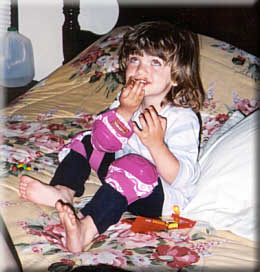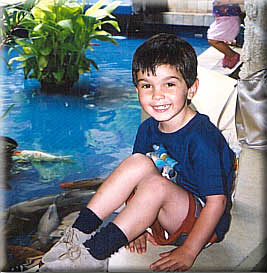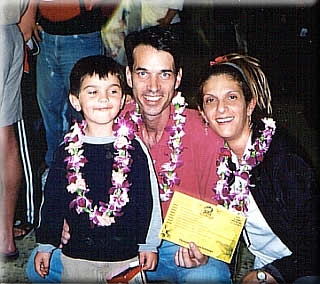Medical Brick Wall
In January of 2001, 37-year-old Bill Hicks stopped at Gemtree Jewelers in Fallbrook, California. His wife, Mojgan, had wandered over there sometime the previous December just to look and had told him how wonderful she thought the store was. With her birthday quickly approaching, Bill decided he would visit the little jewelry shop and see what he could find. His trip resulted in a beautiful gift, and looking back on it today, 38-year-old mesothelioma patient Bill Hicks believes it was the smartest thing he's ever done.
In mid-February 2001, Bill started experiencing trouble breathing after doing anything in which he exerted himself for any prolonged period, such as walking up a flight of stairs. By the beginning of March, he could no longer lay down, and he could only sleep two or three hours at a time, propped up on a sofa so that he wouldn't suffocate. He started using sick days for the first time in his working life.
In mid-March, at the insistence of Mojgan, Bill visited his primary care physician who diagnosed severe allergies, prescribed asthma medication and Claritin-D, and sent him on his way. After a week of medication, with no visible signs of relief, Bill called his doctor back who advised patience and resorted to the usual cliché that there would be "good days and bad days."
FROM BAD TO WORSE
With worsening pain hounding him day and night, Bill visited a chiropractor/kinesiologist two to three times a week to allay the pain. He thought his neck muscles might be the problem and that professional manipulation of the joints in his neck might offer a solution. Bill and Mojgan researched other options and tried herbal supplements and vitamins, as well as therapy focusing on the healing potential of one's pressure points.
Still, the pain persisted. Two months after the onset of the pain, Bill finally succumbed to Mojgan's pleadings and visited Palomar Medical Center in Escondido, California, on April 22, 2001, thinking that he would receive another, stronger medication for allergies of some kind and then go home. The doctor listened to Bill's chest with a stethoscope but did not hear the usual sounds associated with a healthy lung. He immediately ordered a chest film, which subsequently showed that Bill's left lung cavity was completely obstructed with fluid or worse. The doctor performed a thoracentesis, withdrawing six liters of fluid from Bill's left pleural cavity.
The problem was not one of benign allergies and Bill was not going home.
THREE WEEKS OF CONFUSION
At 11 o'clock that night, Bill called Mojgan, telling her he had been admitted to the hospital, and the doctors wanted to run more tests to determine what was causing his illness. For the first two weeks, thoracenteses were repeatedly performed, and several liters of fluid were drained from Bill's chest. Samples of the fluid were sent to the pathology lab, but the tests resulted in benign findings only. Blood bacteria tests yielded nothing of concern.
Bill's father and his brother, Robert, are both doctors. They were mystified by what he told them. Robert mentioned mesothelioma, but tried to rule it out because of Bill's tender age. Even Bill's doctors at the hospital seemed reluctant to mention cancer, largely because of Bill's youth.
In the meantime, Mojgan shuttled back and forth between the house and the hospital, her children and her husband, at first leaving Shariar and Sharareh in the care of a trusted babysitter, and then with Bill's own mother after she had come down from Maine.
After two weeks of testing and speculation with no conclusive verdict, the doctors decided to go in. They thought Bill's problems might be attributable to an aneurysm and the doctor wanted to expand Bill's lung to have a better look.
On May 3, 2001, the surgeon discovered a massive tumor wedged between Bill's heart, lung and diapghram. A biopsy specimen was removed and sent to the pathology lab for evaluation.
At 10:30 in the morning on May 7, 2001, an oncologist, walked into Bill's room and gave him, his mother and Mojgan the news. He told them that Bill had malignant mesothelioma and just nine months to live. The oncologist made some other brief remarks, but there was no one listening. Upon hearing the one-two punch of diagnosis and prognosis, Bill seemed to go deaf.
NO ONE'S LEAVING ANYTIME SOON
Bill's wife, Mojgan, was born in Iran in 1968. To escape her father and his family, she and her mother fled the country to Austria when she was just eight years old. For the next 15 years, she traveled the world, living in places such as Nigeria and England, graduating from the University of London in 1991 with a degree in computer science. She entered into Immigration and Naturalization Services' Diversity Visa Lottery Program and was one of the lucky ones to be selected for a visa to live in the United States. She moved to San Diego and began working there that year.
Almost four years later, a friend set her up on a blind date with a young American named Bill who had just moved out to California looking for work. Within six months, they were engaged, and on November 4, 1995, they were married.
Mojgan and Bill both describe their relationship as love at first sight. They were fascinated by each other. For the first time in his life, Bill found someone with whom he wanted to settle down. For the first time in her life, Mojgan found a man upon whom she could depend and who she believed would make the kind of good father she had never known. They skied together every weekend while they were first married, traveling to such places as Steamboat in Colorado and Mammoth in California for the sights and for the powder. While Mojgan was pregnant with their first child, they bought a fixer-upper in the town of Escondido in California that they worked on until moving into their new home in Fallbrook. Their son, Shariar, was born on September 17 in 1998, and on January 5, 2000, they had a daughter, Sharareh. They had both found happiness that they had never imagined possible.
Now, however, an oncologist was telling Bill he would be gone in nine months. All Mojgan could say was "Bill, stay positive. This is up to God." Remembering an old adage and wanting to get as much of God's help as they could, the Hicks started helping themselves, embarking on a determined and systematic hunt for knowledge.
FOUR DOCTORS, FIVE DAYS
With doctors at Palomar offering little, Mojgan mobilized her husband's family and gave them all assignments to complete within the next 48 hours. The enemy was mesothelioma, and they were instructed to search for any weapons that may exist to exterminate this beast.
Mojgan learned of several treatment options. She discovered Dr. David Sugarbaker and his extra- pleural pneumonectomy (EPP) procedure in Boston. She read about alternative treatment protocols for this "incurable" disease as far away as China, India and Australia, and as close as Tijuana, Mexico. She contacted every doctor and non-doctor she could.
She visited Bill every day, except on May 12th, the day she visited Mexico to research the Tijuana alternative treatment clinics in person. The next day, she assembled her print outs, articles, pamphlets and notes and brought them to Bill in the hospital. Mesothelioma did not have to be the end of the world they knew, and Mojgan wanted to show him the proof.

Mojgan scheduled Bill for a consultation with Dr. Sugarbaker and despite several attending doctors' objections, cleared the way for him to go. It was then that they heard of Dr. Robert Cameron and his pleurectomy / decortication (P/D) procedure at UCLA Medical Center, thousands of miles closer and definitely more convenient than Boston, especially given Bill's health. They postponed their appointment with Dr. Sugarbaker and set up a consultation with Dr. Cameron.
Three weeks later, on June 3, the Hicks met with Dr. Cameron to learn more about the procedure and discuss Bill's eligibility. pleurectomy / decortication is a multi-modal therapy in which the surgical team makes an excision (cutting away) in the pleura (the serous membrane around the lung), removing the surface layer of the lung or part of the surface lung tissue, along with any other layers of other organs (such as the diaphragm) where the cancer or tumors may be present. During or after the surgery chemotherapy is generally administered, followed by radiation treatments. These radiation treatments are usually directed at the areas of highest risk for recurrence. Hopes ran high, as it looked that this treatment might possibly increase Bill's chances of extended survival, and the therapy was practically located in their own backyard.
Upon further review of Bill's slides and medical records, however, Dr. Cameron delivered the bad news. The cancer had metastasized to Bill's lymph nodes, and with nodal involvement, he was ineligible for the pleurectomy / decortication procedure as a first strike option. Dr. Cameron, however, did suggest Alimta (link) as a viable treatment alternative for Bill. The idea was to first see if the tumor would respond to chemotherapy. If it did, then surgery was a viable option for meaningfully extending the patient's life.
One door had closed; another had opened. Mojgan rescheduled Bill for a June 15th appointment with Dr. Sugarbaker. They were now expecting Dr. Sugarbaker's procedure of extra-pleural pneumonectomy (EPP) to be the answer to their prayers, and they wanted this to be the last visit. In the meantime, Bill would visit three other doctors, including Dr. Stanislaw Burzynski in Houston. The clock was ticking for Bill, but his tumor had all the time in the world.
Bill made a whirlwind tour of the country, starting with the Cancer Therapy and Research Center (CTRC) in San Antonio, Texas, on Monday, June 11, to learn more about Alimta. Tuesday, he journeyed halfway across the Lone Star State to visit Dr. Roy Smythe at the University of Texas MD Anderson Cancer Center in Houston. Wednesday, he and Mojgan visited Dr. Burzynski at the Burzynski Clinic -- also in Houston -- and on Thursday, Mojgan returned home, while Bill and Toni pressed on to Boston for Bill's Friday appointment with Dr. Sugarbaker.
Dr. Sugarbaker looked at Bill's scans, MRIs and slides. Within minutes, he advised that they would shoot for a cure. Dr. Sugarbaker was refining the methodology to his EPP by rotating which drugs were to be used in the heated intracavitary chemotherapy wash, in which chemotherapy is heated to several degrees above the normal body temperature and washed around inside the chest cavity -- where the damaged lung had been prior to surgery -- in an effort to kill microscopic cancer cells that resection may not eliminate. He was still awaiting final Food and Drug Administration (FDA) authorization to proceed with the next round of surgeries. He sent Bill back to California, advising him they would contact him shortly and give him the "green light" to return for the actual surgery. Bill returned home to Mojgan, more hopeful than he had been in months.
A STEP FORWARD, A STEP BACK
Bill and Mojgan were feeling relieved. Their visit with Dr. Cameron had disheartened them. It was difficult for them to understand why, in view of Bill's youth and otherwise excellent health, the nodal involvement would preclude him from an immediate P/D.
Additionally, the Hicks had eliminated Alimta from their plans because they couldn't rationalize how the levels of toxicity that Alimta would infuse into Bill's body would kill the cancer and allow him to survive.
They eliminated Dr. Smythe's suggestion of a surgical biopsy followed by radiation and started Bill on a regimen of chelation and acupuncture; the chelation would remove metallic impurities from his blood and the acupuncture would stimulate the "energy" in his pressure points. Further, in an effort to maintain his health until his surgery with Dr. Sugarbaker on August 8, Bill restricted himself to a vegetarian diet composed solely of organic foods according to the theory that organic foods can substantially increase the alkaline level in one's body. The reason for this is best stated by fellow mesothelioma patient Dennis Harline: "Cancer cannot live in an alkaline state." It was, in fact, Dennis to whom the Hicks had first turned when searching for information on how to eat and how to live with mesothelioma.
Bill's surgery began well on August 8th. Upon entering Bill's chest, Dr. Sugarbaker was surprised to find that Bill's tumor had not grown since his scans on May 7th. This sweet surprise, however, quickly turned sour.
When Bill woke up from the surgery, oddly enough he knew something was amiss. His left lung was still in his chest -- as was his diaphragm, as was his pericardial sac. He knew the surgery had been aborted and along with it, this shot at a cure.
Two hours into the surgery, Dr. Sugarbaker had emerged from the operating room and informed Mojgan that the tumor had extended its tendrils to wrap in and around Bill's esophagus. As a result, he was aborting the procedure. To try to extract the tumor at that point, he told Mojgan, would be to allow Bill to bleed to death.
In retrospect, Bill has no regrets about Dr. Sugarbaker's life or death call. Bill has learned perspective. In his mind, he did everything he could to help his cause, and in the end, he wound up with more than he would have had. On the bright side, he still had more lung capacity with which to fight the disease than if the EPP had been successfully completed. He wasn't exactly crazy about the idea of losing his lung in the first place.
Two days after the surgery, Dr. Sugarbaker spoke with Bill and Mojgan. He recommended that Bill try chemotherapy at adjacent Dana Farber. After that, Dr. Sugarbaker would attempt to complete the original surgery, as long as the chemo had shrunk the tumor. This again was what Dr. Cameron had originally advised.
The vision looked promising, but doubts nagged at Mojgan. She was growing disillusioned. She asked Dr. Sugarbaker what guarantee could he give that he would be able to complete the EPP. He admitted he couldn't guarantee anything except "best efforts" on the simple (if not simplistic) theory that something was better than nothing.
That in mind, Bill and Mojgan consulted with Dana Farber. The doctors there cautioned against chemotherapy and suggested that Bill try Alimta, something the couple had already declined. After all the consultations, all the promising scenarios, all the experts and all the travel, blood, sweat and tears, Bill and Mojgan were back at square one, feeling alone and abandoned.

Mojgan had been giving Bill aloe vera in liquid form since his surgery, contrary to doctors' orders; the healing of his wounds had progressed remarkably quickly, and in three to four days after his surgery, Brigham and Women's Hospital in Boston released Bill in almost record time, allowing him and Mojgan to return home and contemplate their next move.
For the next month, Bill rested, sticking to his strict diet and recovering some of his strength while he healed from surgery and pondered his next step.
NEXT MOVE
Shortly after Bill's diagnosis in May, a tired Mojgan followed her intuition and went to go visit the jewelry store her husband had visited for her just a few months before. Upon arriving at the store, Mojgan and the owner, Ron, struck up a conversation, and she told Ron that Bill had come down with an incurable form of cancer. Ron paused, looked at her, and walked over to his Rolodex. He flipped through and pulled out a card for Dr. Stanislaw Burzynski. As it turned out, Ron's brother-in-law had suffered from cancer, had heard about the Dr. Burzynski's clinic in Houston, but had passed away before making the trip. Mojgan took the information, thanked him, and left.
Bill and Mojgan stopped at Stanislaw Burzynski's clinic on Bill's whirlwind medical survey of the country. Now, while recovering from the aborted EPP, they hoped that Dr. Burzynski and his antineoplaston theory of treatment would pick up the pieces.
Dr. Burzynski states that antineoplastons, are "non-toxic, naturally-occurring peptides, amino acid derivatives and certain organic acids that fight cancer with few if any side effects." His theory is that antineoplastons switch "off" the genes in our bodies that cause cancer, in addition to turning "on" the genes that fight cancer (tumor suppressor genes). The therapy can be administered orally (capsules), through a pump or intravenously.
The Hicks' went for Bill's first treatment in early September, and are currently awaiting their second visit in early December, when it will have been three months since Bill began the therapy. At that time, they will determine if the therapy is affecting the growth of the tumor.
Shariar and Sharareh are heading to day care. Mojgan is off to take classes, brushing up on her computer skills, particularly Oracle and Java, to enhance her computer science degree of a few years ago and improve her job marketability so that she may return to working in a field she loves. Bill eats one of his meals prepared entirely from organic foods -- vegetables, proteins, alkalides -- before he goes to work at his division of communications giant Kyosera (formerly of technology-leader Qualcomm), designing circuit boards. He tries not to think about the prognosis his first doctor gave him five months ago, and he tries not to look back, but forward, to each new day and the future.
We will keep you posted on the progress of this valiant couple.
*** POSTED OCTOBER 18, 2001 ***
An Update -- 7/18/02
Bill has decided not to pursue chemotherapy. Instead he has chosen treatment through acupuncture along with natural herbs and diet. His pain is controlled by medication. To keep himself mentally fit he tries to work on a part-time basis. Mojgan expresses concern about Bill's weight loss, his weight is down to 146 pounds from his normal 180. She says they are not good at coping with what they know is coming. It is hard to find the words to express what they are feeling right now. However, it is not as hard to express the anger and resentment she feels toward the "people" who have put them in this situation. She thinks of their two children and is saddened by what the future holds for them.
William Hicks passed away on October 29, 2002
October 29, 2003
A tribute to my husband :
Today a year ago my husband William Patrick Hicks passed away. Even though it has been a year I still feel his presence in my heart. He is very much alive in the hearts of myself and my children.
The challenge to overcome the pain on what this horrific illness has done to this family will go on for as long as I live. It not only took my husband away from me, but I lost my best friend.
Yes, more than anything me and Bill were the best of friends. We confided in one another about everything and anything. There were no two people that were better friends. That is the part I miss the most and will never be able to replace. He was always there and available to be a friend. His heart was filled with hopes and desires and lightness about our future. The day I married him was a fairy tale day. I felt I was waking up to the Cinderella movie. He captured my heart and he captured my soul. I was in absolute awe of him.
I feel part of my existence parted with him. There are days when I remember our laughter together excited about the beautiful future that awaited us as a result of the deep passion and love we had for one another. This love and passion gave us two children through whom I see Bill.
He is the only man I will ever know how to love. Not one day goes by that I hope that I can wake up to find out that this was just a bad nightmare and he is still here. But, then I realize that will never happen and my heart bleeds and tries and tries and keeps trying to go on.
He will always be alive in our hearts.
From Mojgan, Shahriar, Sharareh Hicks
Thank You
October 29, 2004
A tribute to my sweetheart, my hero and my legend Bill Hicks:
My dear Bill, today is the second year anniversary of your passing and still not one moment goes by that I stop thinking of what we shared together. The passion, the energy, the pain, the force of the love we shared keeps vibrating and is as real as any possession you can touch on the planet.
Even though you are not here physically your memories with me and the children is helping us survive the dark hours. The pain of not being there at your funeral and to say goodbye to you is becoming touchable. If you are watching us and see what happened here just protect the children from the pain that those actions of your brother and mother directly transferred into their hearts. They wonder and they wonder why and I try my hardest to keep you alive in their hearts. So far it has been semi successful but to have had you near us would have been the kindest gift we could ask for. To feel that you are close to us would be have helped our healing process.
My dear husband, my dearest and best friend, you are a hero, you are a legend and your work on the earth is an energy me and our children are able to carry with us with pride to know that we are all as ONE. We are a unit and no matter where your location maybe we will always remain as ONE in this universe.
You endured an tremendous amount of pain and you did it with so much grace and everything you did was because you wanted to protect me and the kids. We live in your legacy and in your grace. We are who we are because of your strength and your kindness.
May your soul rest in peace knowing what you have brought to our lives. Your son is getting to know you little by little and is so proud of you and i intend to keep that alive. Your daughter knows everyday how much you adored the ground she walked on. They are both in touch with the feelings you have for them. My mission to reiterate that will not end as long as I live.
From your wife who worships you and from your children who believe in you.
Regards
Mojgan Hicks


